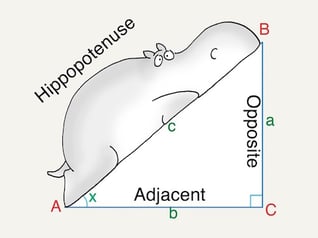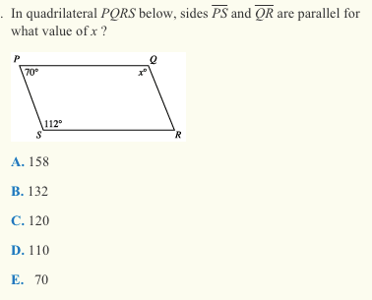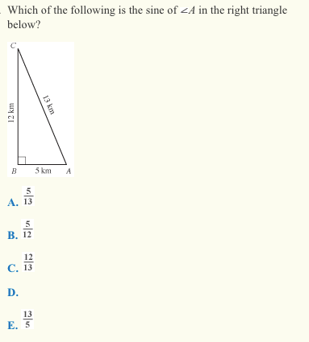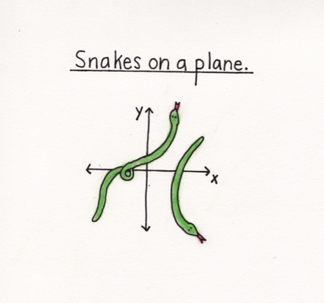
Have you not taken a geometry class yet, or do you feel like geometry's not your strong suit? If that's the case, how well can you do on the ACT without a strong knowledge of geometry?
Let's approach this by first considering how many of the math questions on the ACT cover geometry and, its close relative, trigonometry.
How Much Geometry and Trigonometry Are On the ACT?
The math section on the ACT asks 60 questions in 60 minutes. The exact number of geometry questions varies between 35% and 45%, so you might encounter between 21 and 27 geometry questions, a significant portion.
5% to 10% more cover trigonometry, which might involve relations in right triangles or functions. This equates to about 3 to 6 more questions.
To break all of geometry down into more specific topics:
- Coordinate Geometry, 15-20%, 9 - 12 questions
- Plane Geometry, 20-25%, 12 - 15 questions
- Trigonometry, 5-10%, 3-6 questions
- Total, 40-55%, 24 - 33 questions
The remainder of the ACT math sections covers algebra, including pre-algebra, elementary algebra, and intermediate algebra. Let's take a closer look at the concepts covered within geometry and trigonometry. Even if you haven't taken a geometry class, you might have a working or intuitive understanding of some of these concepts.
What Concepts In Geometry and Trigonometry Are Covered?
Coordinate Geometry
Coordinate geometry covers the following concepts:
- Graphing and relations between equations and graphs, including points, lines, polynomials, circles, and other curves
- Graphing inequalities
- Slope
- Parallel and perpendicular lines
- Distance
- Midpoints
- Conics
For example, the following problem tests your understanding of graphing and distance, as well as a basic understanding of what a rectangle is, which overlaps with the next subtopic: plane geometry.

Answer: F
Plane Geometry
Plane geometry questions cover
- Properties and relations of plane figures, including angles and relations among perpendicular and parallel lines
- Properties of shapes, like circles, triangles, rectangles, parallelograms, and trapezoids
- Transformations
- Proofs and proof techniques
- Volume
- Applications of geometry to three dimensions
For instance, the following problem asks you to draw on your understanding of parallel lines and properties of shapes, including both angles and relations among parallel lines.

Answer: D
Trigonometry
The trigonometry questions might cover these concepts:
- Trigonometric relations in right triangles
- Values and properties of trigonometric functions
- Graphing trigonometric functions
- Modeling using trigonometric functions
- Trigonometric identities
- Solving trigonometric equations
The following example problem tests your understanding of trigonometric relations in a right triangle.

Answer: C
As you can see, there are several subtopics within each of these areas that might be covered by questions on the ACT. If you have little to no knowledge of geometry or trigonometry, how well can you expect to score on the math section of the ACT?
What Score Can You Get Without Geometry or Trigonometry?
Let's say you skipped every single geometry question on the ACT and answered all the remaining math questions perfectly. In this scenario, the highest score you could get (out of a maximum 36) would be between 21 and 24. This depends on exactly how many geometry questions there were.
However, if you're not familiar with geometry, it's probably safe to assume you don't have much experience in trigonometry, either. So if you skipped all the geometry and trigonometry questions, while answering the remaining ones correctly, the highest score you could get would be somewhere between 18 and 23.
Where exactly did I get these estimates? Take a look at the score chart below to see how your raw score gets scaled to a score between 1 and 36 on the ACT. Remember your raw score is simply the number of questions you answer correctly.
I cut this scoring chart off at 13, but it is possible to score as low as 1. If you're interested in the full scoring charts of all sections of the ACT, check out this article here.
|
Raw Score |
Scaled Score |
Raw Score |
Scaled Score |
|
58-60 |
36 |
38 |
24 |
|
57-58 |
35 |
40 |
23 |
|
55-56 |
34 |
36-37 |
22 |
|
54 |
33 |
34-35 |
21 |
|
53 |
32 |
33 |
20 |
|
52 |
31 |
31-32 |
19 |
|
50-51 |
30 |
29-30 |
18 |
|
49 |
29 |
27-28 |
17 |
|
47-48 |
28 |
24-26 |
16 |
|
45-46 |
27 |
19-23 |
15 |
|
43-44 |
26 |
15-18 |
14 |
|
41-42 |
25 |
12 - 14 |
13 |
As you can tell from the math questions and scoring charts, geometry and trigonometry really are a significant part of the math section of the ACT. So if you haven't taken these courses in school before you're sitting for the ACT, what should you do?

ACT Math Takeaways
Even if you've never taken a class in these areas, you can still help yourself out a huge amount by studying on your own. Test prep materials are really helpful in breaking down each concept and giving you plenty of focused practice in applying these skills.
Some questions, especially those regarding shapes and coordinate geometry, may even be intuitive. You'll likely be able to answer several questions with just a basic knowledge of geometry and some practice. The scenario described above, where you skip all these questions, really never needs to occur, even for students who haven't taken a geometry class yet in their high school career.
You might also want to consider taking the SAT instead of the ACT. The SAT also requires your understanding of geometry, but it actually does not cover trigonometry. This article gives you the full breakdown of how much geometry is on the SAT.
So don't give up on math; instead, use your gap in knowledge to drive your studying and strengthen your skills with self-studying. It will go a long way toward raising your ACT math score.
What's Next?
When are you planning the take the ACT? Depending on what year you're taking it, you will have different target scores in mind. Read about what's a good score for a freshman, for a sophomore, and overall for your college applications.
Preparation is everything with the ACT. Read these vital tips and strategies for designing your ACT study plan.
Are you aiming for perfection? These tips by a full scorer will help you raise your scores and even achieve a perfect 36.
Want to improve your ACT score by 4 points?
Check out our best-in-class online ACT prep program. We guarantee your money back if you don't improve your ACT score by 4 points or more.
Our program is entirely online, and it customizes your prep program to your strengths and weaknesses. We also have expert instructors who can grade every one of your practice ACT essays, giving feedback on how to improve your score.
Check out our 5-day free trial:
Have friends who also need help with test prep? Share this article!
Rebecca graduated with her Master's in Adolescent Counseling from the Harvard Graduate School of Education. She has years of teaching and college counseling experience and is passionate about helping students achieve their goals and improve their well-being. She graduated magna cum laude from Tufts University and scored in the 99th percentile on the SAT.


































 Holly R.
Holly R.